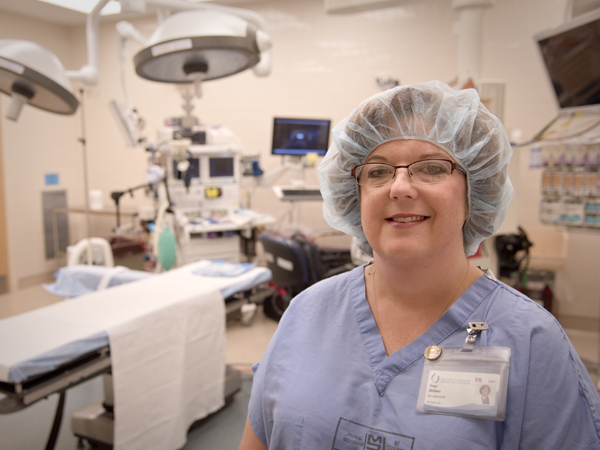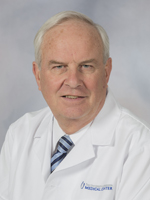Giving patient safety a voice

Published in News Stories on August 20, 2015
Several years ago, registered nurse Kaye Nations spoke up when she thought a patient's vital signs didn't look quite right just minutes before he was to undergo a gastrointestinal procedure at the University of Mississippi Medical Center.
While some might have hesitated to share their concerns with the doctor, Nations did not.
"I didn't feel like we needed to proceed," Nations said. "I had sedated the patient the day before, and I knew his baseline. He'd come in for a repeat procedure, and I was concerned about his airway. I told the attending physician that I was concerned, and he agreed and we didn't start the procedure."
As it turned out, the patient had suffered a pulmonary embolism. "Had we proceeded, he could have died or ended up in intensive care," Nations said.
She's one of almost 3,000 UMMC employees who have undergone required training to keep their individual workplace safe and free of errors or other actions that can result in harm to patients. It's part of a cultural evolution and shift in thinking designed to prevent harm from happening in the first place.
That's being achieved by creation of a no-fear zone in which all are free to ask questions or voice concerns regarding patient safety -- and where employees welcome being questioned by others.
Although a specific error wasn't in the making when Nations brought her patient's vital signs to the attention of his physician, Nations did what's being emphasized in error prevention training. She spoke up because she was concerned for the patient's safety, and she felt comfortable doing it.

Henderson
"A lot of this is about the culture at UMMC, and about chasing zero for preventable harm," said Chief Medical Officer Dr. Michael Henderson, who also is a veteran transplant surgeon. "A decade ago, people didn't buy into this. But many of the things we used to think weren't preventable are now preventable."
"Quality and safety are now our focus," said Shannon Wentz, administrator for Henderson's office.
Henderson's office is making progress not just in getting more of UMMC's 10,000 employees engaged and trained, but in tracking whether the training is playing a role in both prevention of patient harm and the comfort level of employees wanting to report areas of concern. That's being achieved in part through the Medical Center's I Care (I Communicate At Risk Events) electronic reporting system that makes it quick and easy for any employee to electronically pass on information on unsafe events or close calls.
The reporting includes not just patient care issues, but lapses in equipment safety, staff behavior, infection control, infrastructure failure, and security or medication-related issues. Employees can make a report by clicking on "Healthcare" in the top bar on the Intranet home page, then going alphabetically to I Care Report to fill out a short form.
Also, the Medical Center's computers have a desktop "I Care Report" icon that can be clicked to retrieve a reporting form. Reports can be anonymous, although employees are encouraged to identify themselves in case there are follow-up questions.
The error prevention training program kicked off in September 2014, with Dec. 31, 2016, the target date for completion of all training. Those already trained includes about a quarter of UMMC's front-line clinical employees, Wentz said. The number also includes 763 in the School of Medicine, 172 in University Physicians, 391 in Shared Services, and 258 in Physical Facilities and Environmental Services.
"A third of the workforce has gone through, but disproportionately, few of the clinical front-line employees," Henderson said. "We want to get trained the people who are truly touching patients on a daily basis."
The training lasts about two and one-half hours. To sign up, log into HealthStream from the UMMC Intranet. Select Catalog, then click on the Patient Safety folder. Select Error Prevention Training on the right side of the page, then register for a class.
Classes aim to empower employees to take a fresh look at decreasing errors that can lead to patient harm, and to question whether a particular decision or action might adversely impact a patient. They are learning what safety means to their particular work area, and how they can use tools from training to put safety first.
The training emphasizes employee engagement and holding each other accountable, Henderson said.
"Doing the training is one thing. Asking employees to go out and practice it is another," he said. "The theory is easy. Just remember that one day, we're all going to be a patient. It's asking the question: If it were me there, how would I want to be treated? You are never wrong to put yourself in the patient's shoes and ask that question."
Although she was trained after speaking up about her patient, Nations said, it reinforced her readiness to always look out for the patient, no matter what.
"It really brought to mind how we are all accountable for safety, not just to patients, but anyone who comes on campus, including our own staff," Nations said. "I really like the idea of everyone being able to express their concerns."
Examples of scenarios that might be discussed during training include:
During a surgery, a resident might contaminate the sterile field surrounding an incision. The nurse sees it happen; the surgeon does not. The nurse or the resident should ask that the procedure be stopped immediately because the field is contaminated.
A spill occurs on a unit floor and housekeeping is deployed to clean it up. The housekeeper is stopped by a laboratory technician who gives her information she wasn't previously given: The spill is actually a radioactive fluid that requires a special method of cleaning.
Kelly Dismuke, associate director for administration and finance in the Department of Medicine, was among the first employees to be trained last fall.
She said she had a little trouble before the training questioning others' decisions, "and I don't think it was totally to do with the existing culture. That's a Southern thing. It was nice during the training to hear someone say it's OK for you to say that something's not the right thing."
Both employees and managers are learning that they are "200 percent accountable" for patient safety when they come to work, said Dr. Phyllis Bishop, professor of pediatrics and UMMC's chief quality officer.
"That's 100 percent for yourself and 100 percent for your co-workers. You would never knowingly allow your co-worker to make a mistake," Bishop said. "It's all about checks and balances to make UMMC a harm-free zone. To do that, you have to have 100 percent of people who are working in patient-care areas on board and understand what's expected."
Dismuke said her department, under the leadership of the late Dr. Bill Little, "identified early that this is something important, and we wanted to make sure we were getting everyone the required training.
"From my perspective as an administrator, it gave me insight into the Medical Center's clinical work. I don't work in that daily. It gave me insight into the complicated decisions that people have to make every day.
"It was important to me to hear people reinforce that we are in a culture of accountability, and that we are in a culture of questioning."
That's the idea behind the training, Henderson said.
"We need to be willing to pause and ask the questions, and speak up and say, 'This doesn't feel right,' " he said. "This is about training the senior people to listen to the more junior people on the team. If someone raises a concern, treat it seriously."


